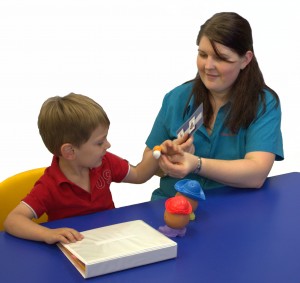
Using language to make choices helps children understand that they can use language to have an effect on the world around them. Children want to communicate more as they learn that language can help them to get what they want. This is powerful motivation, especially for toddlers who are developing the need to be more independent. A motivated child will communicate more and in turn learn more skills. Even children with very limited communication skills can be helped to make choices.
To help your child make more choices try the following ideas:
Develop the habit of offering choices as often as you can. As adults we often make small decisions for children that they could make themselves which would allow them to learn and develop communication skills. Often these small things don’t really matter, it just takes a little more time for your child to decide, but this is worth it to develop their skills.
Choices can include:
- Which t-shirt to wear
- Which snack to eat
- which cup to use
- Which book to read
- Which movie to watch
- Which toy to play with
Only offer choices you are happy for your child to have. For example if you think you child has had enough biscuits offer a choice of apple or banana. For toddlers being able to choose for themselves sometimes makes things more appealing. They may be more likely to eat the apple if they choose it than if you say “no more biscuits, have an apple now”. Make the choices clear and specific. “Chocolate or strawberry?” will get a clearer response from a young child than “What flavour?” You can gradually broaden the options as your child’s skills develop.
Only offer appropriate choices. There will be times when you are busy and need to choose yourself, such as if you are in a hurry to get to an appointment. There are also things that children are not able to make decisions about such as whether to get in their car seat or whether to hold your hand in a busy place. Be clear about these things. Say “get in your seat now” rather than “do you want to get in your seat” as this is not a real choice. Think of situations when you have the time and your child can make appropriate choices. Make the most of these times by offering as many choices as possible.
Helping your child to choose:
Children can make choices in a variety of ways. Think about the communication skills your child has and offer choices in a way that they can be successful.
This can include:
- Looking at the one they want
- Reaching for the one they want
- Pointing to the one they want
- Using a communication aide such as a picture card or signing
- Using a word or phrase
Start by offering a choice of objects. Get face to face with your child and hold up two objects, one each side of your face. “Do you want the apple? Show the apple to the child and say “apple”. “Do you want banana?” Show the banana and say “banana”. Then hold them each side of your face and watch your child’s response. If they look, point or reach for one item, say the name of it again and give it to them.
When you child can consistently point to objects offer choices with pictures. Use PECS cards if your child has them or make your own pictures of things your child likes using pictures from magazines, catalogues or the internet. Laminate them to make them last longer. Present two pictures, say the names of the items and watch your child to see what they prefer. If needed help them point to the one they are looking at, say its name for them then give your child the object straight away.
When your child can use words to choose you can offer a choice using words. Still keep the choices to only two items to start with. As your child’s skills develop you can introduce describing words “red cup or blue cup” “Bob shirt or Batman shirt”.
Whenever your child makes a choice take this as a chance to expand their communication skills by:
- modelling the name of the object if your child cannot say it
- adding an extra word if your child does say the word
- talking about the item your child chooses
Look for your child making choices all by themselves by looking, reaching, pointing and using words and make us of these moments too.
If you are concerned about your child's communication skills check our information about development at different ages, and our checklists. A speech pathology assessment or therapy may be helpful for you and your child.
For more ideas about developing communication skills check out our website, pintrest page and follow us on Facebook.
Related Blog Posts
If you liked this post you may also like:
Talk with me as I start school
Learn while you wait
Why do services cost what they do?
Using TRAPPED PENGUIN To Grow (part 2)



